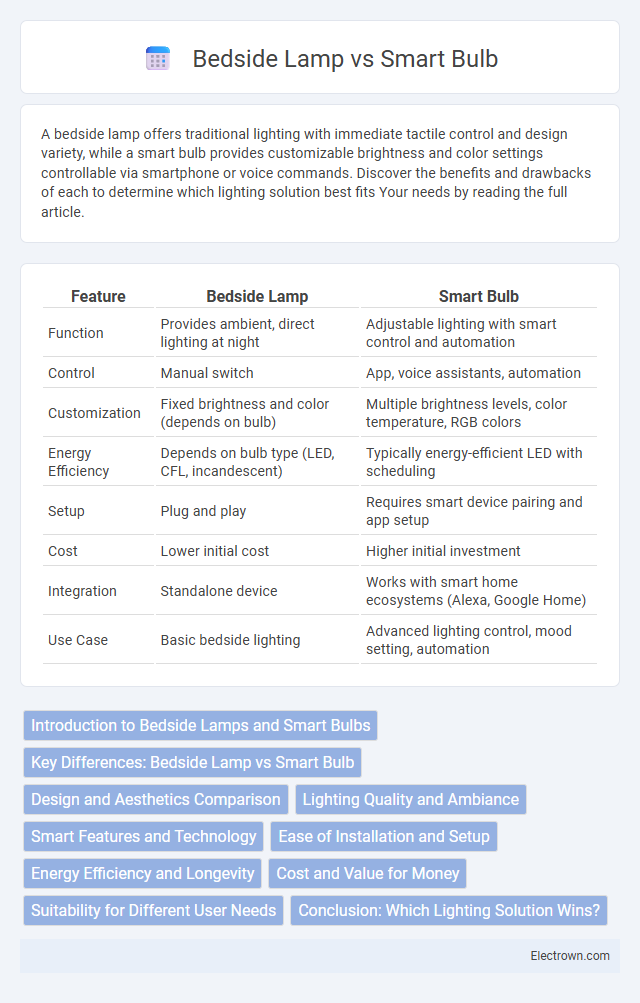A bedside lamp offers traditional lighting with immediate tactile control and design variety, while a smart bulb provides customizable brightness and color settings controllable via smartphone or voice commands. Discover the benefits and drawbacks of each to determine which lighting solution best fits Your needs by reading the full article.
Table of Comparison
| Feature | Bedside Lamp | Smart Bulb |
|---|---|---|
| Function | Provides ambient, direct lighting at night | Adjustable lighting with smart control and automation |
| Control | Manual switch | App, voice assistants, automation |
| Customization | Fixed brightness and color (depends on bulb) | Multiple brightness levels, color temperature, RGB colors |
| Energy Efficiency | Depends on bulb type (LED, CFL, incandescent) | Typically energy-efficient LED with scheduling |
| Setup | Plug and play | Requires smart device pairing and app setup |
| Cost | Lower initial cost | Higher initial investment |
| Integration | Standalone device | Works with smart home ecosystems (Alexa, Google Home) |
| Use Case | Basic bedside lighting | Advanced lighting control, mood setting, automation |
Introduction to Bedside Lamps and Smart Bulbs
Bedside lamps offer focused lighting with adjustable shades and dimmers, ideal for reading and creating a cozy ambiance. Smart bulbs provide customizable lighting solutions through app control, allowing changes in color temperature, brightness, and scheduling. Both options enhance bedroom lighting, but smart bulbs integrate technology for convenience and energy efficiency.
Key Differences: Bedside Lamp vs Smart Bulb
Bedside lamps provide direct, often adjustable lighting with physical fixtures, while smart bulbs offer customizable brightness and color controlled remotely via apps or voice commands. Smart bulbs integrate seamlessly with home automation systems, enhancing convenience and energy efficiency, whereas bedside lamps typically require manual operation and fixed bulb options. Your choice depends on whether you prioritize traditional, tactile control or advanced, programmable lighting features.
Design and Aesthetics Comparison
Bedside lamps often feature traditional designs with various materials like wood, metal, or fabric shades, offering a warm and cozy ambiance that complements your bedroom decor. In contrast, smart bulbs are typically housed in standard, minimalistic fixtures and emphasize functionality over form, integrating seamlessly into existing lamps while enabling customizable lighting effects through apps. Choosing between them depends on whether you prioritize classic aesthetic appeal with physical design elements or modern versatility through digital control.
Lighting Quality and Ambiance
Bedside lamps offer warm, consistent lighting that creates a cozy ambiance ideal for relaxation and winding down before sleep. Smart bulbs provide customizable lighting options, including adjustable brightness and color temperature, allowing you to tailor the ambiance to your mood or activity. Your choice between the two depends on whether you prioritize traditional lighting quality or versatile, programmable ambiance control.
Smart Features and Technology
Smart bulbs offer advanced features such as remote control via smartphone apps, voice assistant integration, customizable color settings, and scheduling options, enhancing convenience and energy efficiency in your space. Bedside lamps typically provide traditional lighting with limited or no smart capabilities, focusing on basic on/off functionality or manual dimming. Choosing smart bulbs allows you to leverage IoT technology for a personalized and adaptive lighting experience tailored to your lifestyle.
Ease of Installation and Setup
Bedside lamps offer straightforward installation, typically requiring just plugging into a power outlet and switching on. Smart bulbs involve a slightly more complex setup, including connecting to a Wi-Fi network and configuring through a smartphone app. Your choice depends on whether you prefer quick, traditional lighting or customizable smart features with an initial tech setup.
Energy Efficiency and Longevity
Bedside lamps using LED bulbs typically consume 60-80% less energy compared to traditional incandescent lighting, while smart bulbs offer similar energy efficiency with added features like remote dimming and scheduling to optimize power usage. The average lifespan of LED bedside lamp bulbs ranges from 15,000 to 25,000 hours, whereas smart bulbs often last between 20,000 and 30,000 hours due to advanced LED technology and integrated smart controls. Energy-efficient lighting investments reduce electricity bills and maintenance frequency, making smart bulbs a practical choice for tech-savvy users seeking both longevity and optimized energy consumption.
Cost and Value for Money
Bedside lamps typically range from $20 to $100, offering immediate, straightforward lighting without complex features, making them a cost-effective option for basic needs. Smart bulbs, priced between $15 and $50 each, provide advanced functionalities such as remote control, color customization, and scheduling, delivering greater value through convenience and energy savings over time. Choosing between the two depends on whether the priority is initial affordability or long-term versatility and smart home integration.
Suitability for Different User Needs
Bedside lamps offer simplicity and ease of use, making them ideal for users who prefer straightforward lighting without technical complexity. Smart bulbs provide customizable lighting options, such as adjustable brightness and color temperature, catering to tech-savvy individuals seeking personalized ambiance and remote control via smartphone or voice assistants. Your choice depends on whether you prioritize ease of use or advanced features for tailored lighting experiences.
Conclusion: Which Lighting Solution Wins?
Smart bulbs offer advanced features like color customization, remote control, and energy efficiency, making them ideal for tech-savvy users seeking versatile lighting. Bedside lamps provide a classic, easy-to-use solution with tactile controls and a cozy ambiance, suitable for traditional settings. The winner depends on user preferences: smart bulbs excel in functionality and integration, while bedside lamps prioritize simplicity and decorative appeal.
Bedside Lamp vs Smart Bulb Infographic

 electrown.com
electrown.com